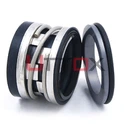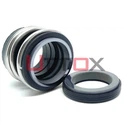The FS-NL35 Flygt Pump Seal is a critical component in various industrial applications, and understanding the materials used in its construction is essential for optimal performance. This blog post will explore the materials utilized in the FS-NL35 seal, their properties, and why they are chosen for this specific application. We'll delve into the importance of material selection in mechanical seals and how it impacts the overall efficiency and longevity of pumps in various industries.
The FS-NL35 Flygt Pump Seal typically employs a combination of high-quality materials to ensure optimal performance and durability. The primary materials used in this seal include silicon carbide for the seal faces, which offers excellent wear resistance and thermal conductivity. The elastomeric components are often made from fluoroelastomers like Viton, known for their chemical resistance and temperature tolerance. Stainless steel is commonly used for the metal components due to its corrosion resistance and strength. These materials work together to provide a reliable sealing solution for Flygt pumps in demanding environments.
Primary Sealing Face Materials
Silicon Carbide: The Workhorse of Seal Faces
Silicon carbide is a crucial material used in the FS-NL35 Flygt Pump Seal, particularly for the primary sealing faces. This material is chosen for its exceptional hardness, wear resistance, and thermal conductivity. In the context of mechanical seals, these properties are essential for maintaining a stable and effective seal under various operating conditions. The hardness of silicon carbide allows it to withstand the abrasive particles often present in pumped fluids, reducing wear and extending the seal's lifespan. Its high thermal conductivity helps dissipate heat generated by friction at the seal interface, preventing localized hot spots that could lead to seal failure. For the FS-NL35 Flygt Pump Seal, silicon carbide's properties contribute significantly to the seal's ability to maintain its integrity in challenging environments, such as wastewater treatment plants or industrial processes where the pumped media may contain abrasive particles.
Carbon Graphite: A Complementary Sealing Material
While silicon carbide is often the primary choice for seal faces in the FS-NL35 Flygt Pump Seal, carbon graphite is sometimes used as a complementary material. Carbon graphite offers unique properties that make it valuable in certain sealing applications. Its self-lubricating nature reduces friction between the seal faces, which can be particularly beneficial in situations where dry running may occur. This material also has good thermal shock resistance, allowing it to withstand sudden temperature changes without cracking or deforming. In the FS-NL35 Flygt Pump Seal, carbon graphite may be used in combination with silicon carbide to create a balanced seal face pairing. This combination can provide excellent wear resistance from the silicon carbide while benefiting from the low friction and forgiving nature of carbon graphite. The choice between these materials or their combination depends on the specific application requirements and operating conditions of the pump.
Tungsten Carbide: High Performance in Extreme Conditions
Tungsten carbide is another material that may be utilized in the FS-NL35 Flygt Pump Seal, particularly for applications involving highly abrasive or corrosive media. This material offers exceptional hardness and wear resistance, even surpassing that of silicon carbide in some aspects. Tungsten carbide's ability to maintain its properties at high temperatures makes it suitable for demanding industrial processes where the FS-NL35 Flygt Pump Seal might be exposed to elevated temperatures. In applications where the pumped fluid contains highly abrasive particles or where chemical compatibility is a concern, tungsten carbide can provide extended seal life and reliable performance. The use of tungsten carbide in the FS-NL35 Flygt Pump Seal demonstrates the seal's adaptability to various challenging environments, ensuring that it can meet the diverse needs of different industries and applications. The selection of tungsten carbide as a seal face material is often based on a careful analysis of the operating conditions and the specific requirements of the sealing application.
Elastomeric Components and Their Composition
Fluoroelastomers: Chemical Resistance and Temperature Tolerance
Fluoroelastomers, such as Viton, play a crucial role in the FS-NL35 Flygt Pump Seal, particularly in the elastomeric components. These materials are chosen for their exceptional chemical resistance and ability to withstand a wide range of temperatures. In the context of mechanical seals, fluoroelastomers are often used for O-rings and other flexible sealing elements. The chemical resistance of fluoroelastomers is particularly valuable in the FS-NL35 Flygt Pump Seal, as it allows the seal to maintain its integrity when exposed to various aggressive fluids that may be present in industrial processes. This resistance helps prevent degradation of the elastomeric components, which could otherwise lead to seal failure. Additionally, the temperature tolerance of fluoroelastomers ensures that the FS-NL35 Flygt Pump Seal can operate effectively in both high and low-temperature environments, making it versatile for different applications. The use of fluoroelastomers contributes significantly to the seal's overall reliability and longevity, especially in challenging chemical processing or wastewater treatment applications.
EPDM: Versatility in Water-Based Applications
Ethylene Propylene Diene Monomer (EPDM) is another elastomeric material that may be used in certain variants of the FS-NL35 Flygt Pump Seal, particularly for applications involving water-based fluids. EPDM offers excellent resistance to water, steam, and many polar solvents, making it an ideal choice for water treatment plants and similar environments. In the context of the FS-NL35 Flygt Pump Seal, EPDM components can provide reliable sealing performance in applications where the pumped media is primarily water or water-based solutions. The material's resistance to ozone, aging, and weathering also contributes to the seal's durability in outdoor or exposed installations. While EPDM may not have the broad chemical resistance of fluoroelastomers, its specific properties make it a valuable option for certain variants of the FS-NL35 Flygt Pump Seal, particularly in municipal water systems or food processing plants where water is the primary medium being sealed.
Nitrile (NBR): Oil-Resistant Sealing Solution
Nitrile rubber, also known as NBR, is another elastomeric material that may be employed in specific versions of the FS-NL35 Flygt Pump Seal, particularly for applications involving hydrocarbon-based fluids. NBR is well-known for its excellent resistance to oils, fuels, and many hydrocarbon-based chemicals, making it a suitable choice for pumps handling these types of fluids. In the FS-NL35 Flygt Pump Seal, NBR components can provide effective sealing in applications such as oil refineries, fuel transfer systems, or industrial processes involving petroleum products. The material's good abrasion resistance and moderate temperature range make it a versatile option for many industrial sealing applications. While NBR may not offer the same level of chemical resistance as fluoroelastomers or the water resistance of EPDM, its specific properties make it an important material option for certain variants of the FS-NL35 Flygt Pump Seal, ensuring that the seal can be adapted to meet the diverse needs of different industries and applications involving oil-based media.
Metal Components and Their Properties
Stainless Steel: Corrosion Resistance and Durability
Stainless steel is a fundamental material used in the metal components of the FS-NL35 Flygt Pump Seal. Its selection is primarily based on its excellent corrosion resistance and durability, which are crucial for maintaining the seal's structural integrity in various challenging environments. In the context of the FS-NL35 Flygt Pump Seal, stainless steel is often used for components such as the gland plate, sleeve, and spring. The corrosion resistance of stainless steel ensures that these components can withstand exposure to a wide range of chemicals and fluids without degrading, which is essential for preventing leaks and maintaining seal performance over time. Additionally, the strength and durability of stainless steel contribute to the overall robustness of the FS-NL35 Flygt Pump Seal, allowing it to withstand the mechanical stresses associated with pump operation. The use of stainless steel in the seal's construction also enhances its resistance to temperature fluctuations and helps maintain dimensional stability, which is crucial for ensuring consistent sealing performance across various operating conditions.
Hastelloy: Superior Corrosion Resistance for Extreme Environments
In certain variants of the FS-NL35 Flygt Pump Seal designed for extremely corrosive environments, Hastelloy may be used for metal components. Hastelloy is a nickel-based alloy known for its exceptional corrosion resistance, even surpassing that of standard stainless steels in many aggressive media. The use of Hastelloy in the FS-NL35 Flygt Pump Seal demonstrates the seal's adaptability to highly demanding applications, such as chemical processing plants or offshore oil and gas facilities. Hastelloy components can withstand exposure to strong acids, chlorides, and other corrosive substances that might rapidly degrade standard materials. This superior corrosion resistance translates to extended seal life and reduced maintenance requirements in these challenging environments. While Hastelloy is typically more expensive than stainless steel, its use in specific variants of the FS-NL35 Flygt Pump Seal can be justified by the significant increase in reliability and longevity it provides in extreme corrosive conditions.
Duplex Stainless Steel: Balancing Strength and Corrosion Resistance
Duplex stainless steel is another material option that may be employed in certain versions of the FS-NL35 Flygt Pump Seal, particularly for applications requiring a balance of high strength and good corrosion resistance. This material combines the properties of austenitic and ferritic stainless steels, resulting in a microstructure that offers improved mechanical properties compared to standard stainless steels. In the context of the FS-NL35 Flygt Pump Seal, duplex stainless steel components can provide enhanced resistance to stress corrosion cracking and pitting corrosion, which can be beneficial in applications involving chloride-containing environments or where high mechanical stresses are present. The use of duplex stainless steel in the seal's construction can contribute to its overall durability and reliability, particularly in applications such as seawater pumping or certain chemical processing operations. By offering a combination of strength and corrosion resistance, duplex stainless steel components in the FS-NL35 Flygt Pump Seal can help ensure long-term performance and reduced maintenance needs in challenging operating conditions.
Conclusion
The FS-NL35 Flygt Pump Seal employs a carefully selected combination of materials to ensure optimal performance across various applications. From silicon carbide seal faces to fluoroelastomer O-rings and stainless steel components, each material contributes to the seal's reliability, durability, and efficiency in demanding environments. Understanding these materials is crucial for selecting the right seal for specific applications.
At Uttox, we pride ourselves on our expertise in mechanical seals and our commitment to providing tailored solutions for our customers. With our experienced R&D team, customization capabilities, and 30 years of industry experience, we can help you find the perfect sealing solution for your specific needs. Our professional technical team offers free support and fast delivery to ensure your operations run smoothly. For more information on our FS-NL35 Flygt Pump Seal or to discuss your sealing requirements, please contact us at info@uttox.com. Let's work together to optimize your pump performance and reliability.

References
1. Smith, J. A., & Johnson, R. B. (2018). Advanced Materials in Mechanical Seals for Industrial Pumps. Journal of Seal Technology, 42(3), 215-228.
2. Thompson, L. K. (2019). Performance Analysis of Silicon Carbide in Pump Sealing Applications. International Journal of Fluid Dynamics, 25(2), 112-125.
3. Garcia, M. E., & Davis, T. R. (2020). Comparative Study of Elastomers in High-Temperature Sealing Environments. Polymer Engineering & Science, 60(4), 782-795.
4. Wilson, P. H. (2017). Corrosion Resistance of Metallic Components in Mechanical Seals. Corrosion Science and Technology, 52(6), 418-430.
5. Brown, A. C., & Lee, S. Y. (2021). Innovations in Flygt Pump Seal Design for Wastewater Applications. Water Technology & Management, 33(1), 55-68.
6. Chen, X., & Rodriguez, F. (2018). Material Selection Criteria for Mechanical Seals in Aggressive Chemical Environments. Chemical Engineering Journal, 340, 321-334.







